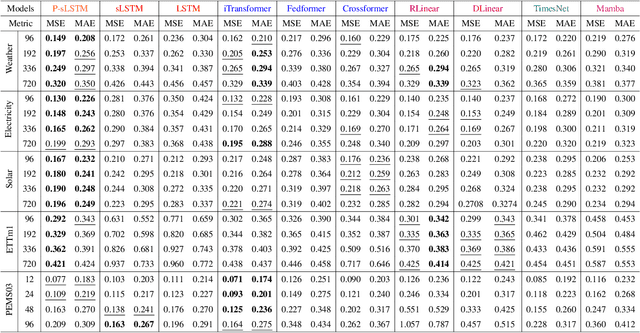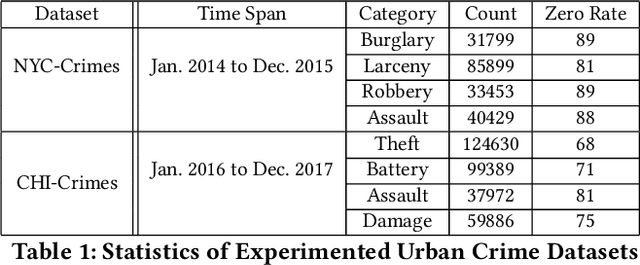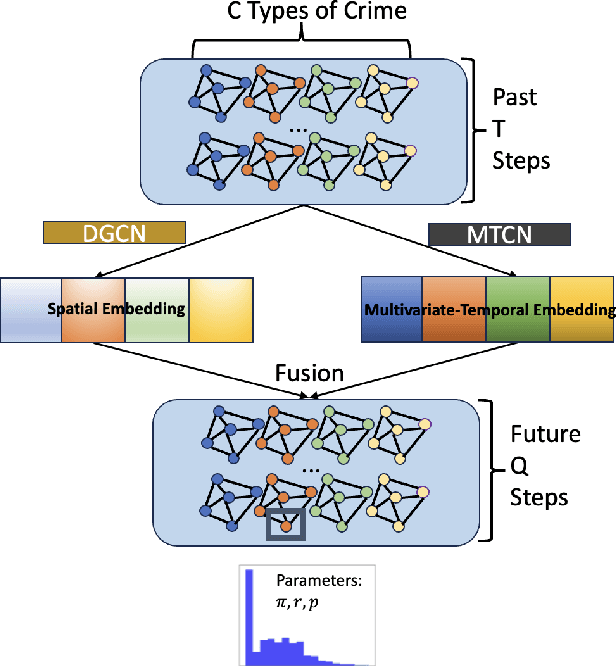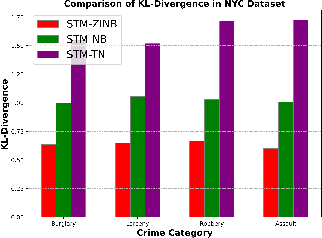Zepu Wang
Domain Adaptation Framework for Turning Movement Count Estimation with Limited Data
Mar 25, 2025Abstract:Urban transportation networks are vital for the efficient movement of people and goods, necessitating effective traffic management and planning. An integral part of traffic management is understanding the turning movement counts (TMCs) at intersections, Accurate TMCs at intersections are crucial for traffic signal control, congestion mitigation, and road safety. In general, TMCs are obtained using physical sensors installed at intersections, but this approach can be cost-prohibitive and technically challenging, especially for cities with extensive road networks. Recent advancements in machine learning and data-driven approaches have offered promising alternatives for estimating TMCs. Traffic patterns can vary significantly across different intersections due to factors such as road geometry, traffic signal settings, and local driver behaviors. This domain discrepancy limits the generalizability and accuracy of machine learning models when applied to new or unseen intersections. In response to these limitations, this research proposes a novel framework leveraging domain adaptation (DA) to estimate TMCs at intersections by using traffic controller event-based data, road infrastructure data, and point-of-interest (POI) data. Evaluated on 30 intersections in Tucson, Arizona, the performance of the proposed DA framework was compared with state-of-the-art models and achieved the lowest values in terms of Mean Absolute Error and Root Mean Square Error.
CRCL: Causal Representation Consistency Learning for Anomaly Detection in Surveillance Videos
Mar 24, 2025Abstract:Video Anomaly Detection (VAD) remains a fundamental yet formidable task in the video understanding community, with promising applications in areas such as information forensics and public safety protection. Due to the rarity and diversity of anomalies, existing methods only use easily collected regular events to model the inherent normality of normal spatial-temporal patterns in an unsupervised manner. Previous studies have shown that existing unsupervised VAD models are incapable of label-independent data offsets (e.g., scene changes) in real-world scenarios and may fail to respond to light anomalies due to the overgeneralization of deep neural networks. Inspired by causality learning, we argue that there exist causal factors that can adequately generalize the prototypical patterns of regular events and present significant deviations when anomalous instances occur. In this regard, we propose Causal Representation Consistency Learning (CRCL) to implicitly mine potential scene-robust causal variable in unsupervised video normality learning. Specifically, building on the structural causal models, we propose scene-debiasing learning and causality-inspired normality learning to strip away entangled scene bias in deep representations and learn causal video normality, respectively. Extensive experiments on benchmarks validate the superiority of our method over conventional deep representation learning. Moreover, ablation studies and extension validation show that the CRCL can cope with label-independent biases in multi-scene settings and maintain stable performance with only limited training data available.
A Survey on Diffusion Models for Anomaly Detection
Jan 20, 2025Abstract:Diffusion models (DMs) have emerged as a powerful class of generative AI models, showing remarkable potential in anomaly detection (AD) tasks across various domains, such as cybersecurity, fraud detection, healthcare, and manufacturing. The intersection of these two fields, termed diffusion models for anomaly detection (DMAD), offers promising solutions for identifying deviations in increasingly complex and high-dimensional data. In this survey, we systematically review recent advances in DMAD research and investigate their capabilities. We begin by presenting the fundamental concepts of AD and DMs, followed by a comprehensive analysis of classic DM architectures including DDPMs, DDIMs, and Score SDEs. We further categorize existing DMAD methods into reconstruction-based, density-based, and hybrid approaches, providing detailed examinations of their methodological innovations. We also explore the diverse tasks across different data modalities, encompassing image, time series, video, and multimodal data analysis. Furthermore, we discuss critical challenges and emerging research directions, including computational efficiency, model interpretability, robustness enhancement, edge-cloud collaboration, and integration with large language models. The collection of DMAD research papers and resources is available at https://github.com/fdjingliu/DMAD.
Data-Driven Transfer Learning Framework for Estimating Turning Movement Counts
Dec 13, 2024Abstract:Urban transportation networks are vital for the efficient movement of people and goods, necessitating effective traffic management and planning. An integral part of traffic management is understanding the turning movement counts (TMCs) at intersections, Accurate TMCs at intersections are crucial for traffic signal control, congestion mitigation, and road safety. In general, TMCs are obtained using physical sensors installed at intersections, but this approach can be cost-prohibitive and technically challenging, especially for cities with extensive road networks. Recent advancements in machine learning and data-driven approaches have offered promising alternatives for estimating TMCs. Traffic patterns can vary significantly across different intersections due to factors such as road geometry, traffic signal settings, and local driver behaviors. This domain discrepancy limits the generalizability and accuracy of machine learning models when applied to new or unseen intersections. In response to these limitations, this research proposes a novel framework leveraging transfer learning (TL) to estimate TMCs at intersections by using traffic controller event-based data, road infrastructure data, and point-of-interest (POI) data. Evaluated on 30 intersections in Tucson, Arizona, the performance of the proposed TL model was compared with eight state-of-the-art regression models and achieved the lowest values in terms of Mean Absolute Error and Root Mean Square Error.
Unlocking the Power of LSTM for Long Term Time Series Forecasting
Aug 19, 2024



Abstract:Traditional recurrent neural network architectures, such as long short-term memory neural networks (LSTM), have historically held a prominent role in time series forecasting (TSF) tasks. While the recently introduced sLSTM for Natural Language Processing (NLP) introduces exponential gating and memory mixing that are beneficial for long term sequential learning, its potential short memory issue is a barrier to applying sLSTM directly in TSF. To address this, we propose a simple yet efficient algorithm named P-sLSTM, which is built upon sLSTM by incorporating patching and channel independence. These modifications substantially enhance sLSTM's performance in TSF, achieving state-of-the-art results. Furthermore, we provide theoretical justifications for our design, and conduct extensive comparative and analytical experiments to fully validate the efficiency and superior performance of our model.
Uncertainty-Aware Crime Prediction With Spatial Temporal Multivariate Graph Neural Networks
Aug 08, 2024



Abstract:Crime forecasting is a critical component of urban analysis and essential for stabilizing society today. Unlike other time series forecasting problems, crime incidents are sparse, particularly in small regions and within specific time periods. Traditional spatial-temporal deep learning models often struggle with this sparsity, as they typically cannot effectively handle the non-Gaussian nature of crime data, which is characterized by numerous zeros and over-dispersed patterns. To address these challenges, we introduce a novel approach termed Spatial Temporal Multivariate Zero-Inflated Negative Binomial Graph Neural Networks (STMGNN-ZINB). This framework leverages diffusion and convolution networks to analyze spatial, temporal, and multivariate correlations, enabling the parameterization of probabilistic distributions of crime incidents. By incorporating a Zero-Inflated Negative Binomial model, STMGNN-ZINB effectively manages the sparse nature of crime data, enhancing prediction accuracy and the precision of confidence intervals. Our evaluation on real-world datasets confirms that STMGNN-ZINB outperforms existing models, providing a more reliable tool for predicting and understanding crime dynamics.
TSI-Bench: Benchmarking Time Series Imputation
Jun 18, 2024Abstract:Effective imputation is a crucial preprocessing step for time series analysis. Despite the development of numerous deep learning algorithms for time series imputation, the community lacks standardized and comprehensive benchmark platforms to effectively evaluate imputation performance across different settings. Moreover, although many deep learning forecasting algorithms have demonstrated excellent performance, whether their modeling achievements can be transferred to time series imputation tasks remains unexplored. To bridge these gaps, we develop TSI-Bench, the first (to our knowledge) comprehensive benchmark suite for time series imputation utilizing deep learning techniques. The TSI-Bench pipeline standardizes experimental settings to enable fair evaluation of imputation algorithms and identification of meaningful insights into the influence of domain-appropriate missingness ratios and patterns on model performance. Furthermore, TSI-Bench innovatively provides a systematic paradigm to tailor time series forecasting algorithms for imputation purposes. Our extensive study across 34,804 experiments, 28 algorithms, and 8 datasets with diverse missingness scenarios demonstrates TSI-Bench's effectiveness in diverse downstream tasks and potential to unlock future directions in time series imputation research and analysis. The source code and experiment logs are available at https://github.com/WenjieDu/AwesomeImputation.
Large Language Models for Mobility in Transportation Systems: A Survey on Forecasting Tasks
May 03, 2024

Abstract:Mobility analysis is a crucial element in the research area of transportation systems. Forecasting traffic information offers a viable solution to address the conflict between increasing transportation demands and the limitations of transportation infrastructure. Predicting human travel is significant in aiding various transportation and urban management tasks, such as taxi dispatch and urban planning. Machine learning and deep learning methods are favored for their flexibility and accuracy. Nowadays, with the advent of large language models (LLMs), many researchers have combined these models with previous techniques or applied LLMs to directly predict future traffic information and human travel behaviors. However, there is a lack of comprehensive studies on how LLMs can contribute to this field. This survey explores existing approaches using LLMs for mobility forecasting problems. We provide a literature review concerning the forecasting applications within transportation systems, elucidating how researchers utilize LLMs, showcasing recent state-of-the-art advancements, and identifying the challenges that must be overcome to fully leverage LLMs in this domain.
SST: A Simplified Swin Transformer-based Model for Taxi Destination Prediction based on Existing Trajectory
Aug 15, 2023Abstract:Accurately predicting the destination of taxi trajectories can have various benefits for intelligent location-based services. One potential method to accomplish this prediction is by converting the taxi trajectory into a two-dimensional grid and using computer vision techniques. While the Swin Transformer is an innovative computer vision architecture with demonstrated success in vision downstream tasks, it is not commonly used to solve real-world trajectory problems. In this paper, we propose a simplified Swin Transformer (SST) structure that does not use the shifted window idea in the traditional Swin Transformer, as trajectory data is consecutive in nature. Our comprehensive experiments, based on real trajectory data, demonstrate that SST can achieve higher accuracy compared to state-of-the-art methods.
ST-MLP: A Cascaded Spatio-Temporal Linear Framework with Channel-Independence Strategy for Traffic Forecasting
Aug 14, 2023Abstract:The criticality of prompt and precise traffic forecasting in optimizing traffic flow management in Intelligent Transportation Systems (ITS) has drawn substantial scholarly focus. Spatio-Temporal Graph Neural Networks (STGNNs) have been lauded for their adaptability to road graph structures. Yet, current research on STGNNs architectures often prioritizes complex designs, leading to elevated computational burdens with only minor enhancements in accuracy. To address this issue, we propose ST-MLP, a concise spatio-temporal model solely based on cascaded Multi-Layer Perceptron (MLP) modules and linear layers. Specifically, we incorporate temporal information, spatial information and predefined graph structure with a successful implementation of the channel-independence strategy - an effective technique in time series forecasting. Empirical results demonstrate that ST-MLP outperforms state-of-the-art STGNNs and other models in terms of accuracy and computational efficiency. Our finding encourages further exploration of more concise and effective neural network architectures in the field of traffic forecasting.
 Add to Chrome
Add to Chrome Add to Firefox
Add to Firefox Add to Edge
Add to Edge